Читать книгу A Companion to the Political Culture of the Roman Republic - Группа авторов - Страница 19
1.4 Concluding Remarks
ОглавлениеThis is exactly why reading Roman popular assemblies as complex webs of discourses is an important challenge for a modern discipline of ancient history that has now (re-)discovered the history of the Republic. In the last few years, the general character of this political culture and its peculiar complexity have only just been outlined – however, a detailed comprehensive account that would meet the new standards remains a desideratum. Nonetheless, at least some central points and coordinates seem to be established: the most important is the extraordinary combination – or rather complementarity – of the pervasive patterns of hierarchies deeply inscribed in this culture on the one hand, and the striking degree of ideological agreement and social coherence on the other. Such a combination is far from being self-evident, let alone natural: not only were hierarchy and dominance, power and its exertion deeply inscribed in the greatest of all social divides, namely between free and slave, as well as between rich and poor; not only were they institutionalised in the formal status differences between populus Romanus, Italian ‘allies’, foreign ‘friends’ and subjects in the provinces; and not only were the societies of Rome, Italy and the empire as a whole suffused by steeply asymmetrical power relations between the ruling and the lower classes.33 The principles of power and hierarchy also openly and even demonstratively structured all political institutions and procedures, assemblies and senate alike, and above all the relations between magistrates and citizens. Last but not least, the same principles were underpinned, affirmed and legitimised by political and social ideology, and even Roman myths and legends revolved around them (see Chapter 34). However, the fact as such does not provide the answer to the all-important question: how could the system have created and successfully upheld such a high degree of acceptance and assent, which was the necessary requirement for subordination and obedience and, in the final analysis, for the functioning of the system itself, so as to achieve this peculiar Roman kind of self-stabilising coherence?
One contributing cultural factor that we can pin down now with some confidence is that the coherence of this political system of the Republic was based upon, and continuously affirmed by, a deeply rooted consensus that was diligently, permanently and, as it were, polymorphically tended by a political class at the summit of all hierarchies, by means of an extraordinarily diversified range of discursive strategies. The identity of this class as a meritocracy was reproduced by a rich repertoire of performative practices, rituals, ceremonies and other symbolic forms of representation that made their culture-specific symbolic capital visible, which was thus used as social credit or creditability and thereby served the manifestation of order by hierarchy. Manifestation and visibility can certainly be taken literally, because all of these aforementioned performative modes and media of representation had to be situated in the public spaces of a city-state, with its ‘culture of personal physical presence’. These spaces were the forums (both meanings of the word apply) of an extraordinarily high degree of civic communication and direct interaction. As such, they were in turn indispensable and indeed constitutive parts of the characteristic political and sacral topography of city-statehood. The immediacy and actual visibility of all procedures and practices, rituals and ceremonies (even for passive spectators) were themselves an integral part of the repertoire of consensus-creating mechanisms in this – as Tonio Hölscher has aptly put it – ‘culture of immediate action’.34
